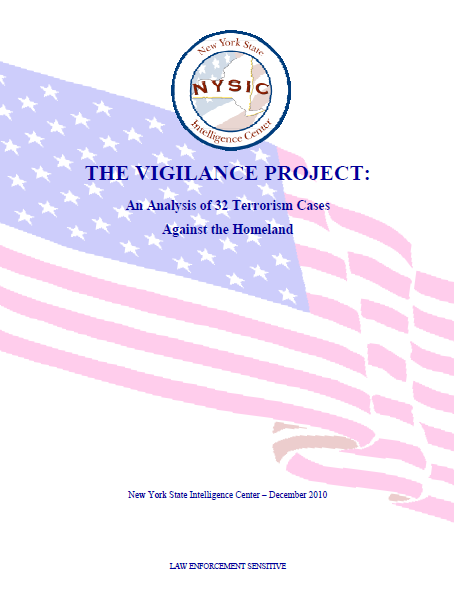New York State Intelligence Center
- 23 pages
- Law Enforcement Sensitive
- December 2010
- 6.23 MB
The Vigilance Project is a comprehensive, analytic report that examines major terrorism cases that have taken place against the Homeland since September 11, 2001. The report serves as a historical compilation of acts or attempted acts of terrorism against the United States, or its interests, and as a tool to identify trends and commonalities among the cases and the subjects involved. It is recognized that the threat environment is dynamic and potential threats are not limited to the findings contained in this report.
As the title suggests, it is the duty of every citizen to remain vigilant in the face of terrorism. The findings of this report allow readers to gain an understanding of terrorism participants, their tactics and procedures, and become aware of similarities among the cases, in order to draw useful conclusions. The ultimate goal of the Vigilance Project is to provide useful information to law enforcement partners to support their role in preventing the next attack.
Key Findings
- There is no definitive terrorist profile. However, we were able to identify trends in basic pedigree information to suggest that these individuals are largely young males, between the ages of 18-33, who explicitly support or follow radical Islamic ideology.
- The threat of ‘homegrown’ terrorism is real. Over half of the individuals
studied in this report were legal United States citizens at the time of their arrest,
with 70% of them natural-born citizens.- U.S. Transportation systems and military facilities remain high-value targets. Transportation systems and military facilities were the most frequently targeted in the cases analyzed in this report, accounting for two-thirds of all identified targets.
- The use of explosives was the most common tactic in Homeland-based plots.
The most popular method of delivery for an explosive was a vehicle-borne improvised explosive device (VBIED). Furthermore, plotters who trained overseas in a specific tactic tended to incorporate those skills into the operational planning, specifically when trained in explosives.- Groups likely form easily when members live in the same community. Research shows four cases where members of the same group were born or resided in the same area during the time of their arrest or involvement in plotting their attack. This is probable since people with similar backgrounds, interests, and social circles are more likely to form common groups.
- Post 9/11, New York State remains the primary target for terrorists. One third of the cases represented in this report involved either a terrorist attack within New York State, or a terrorist cell based there.
This report is a first step in a continuing effort to identify and analyze commonalities among U.S.-based cases. Since the threat of acts of terrorism against our Homeland will likely continue—particularly terrorist plots targeting New York State—the collection and analysis of terrorism information that assists law enforcement and homeland security partners in preventing future attacks will be an ongoing effort at the New York State Intelligence Center (NYSIC).
…


